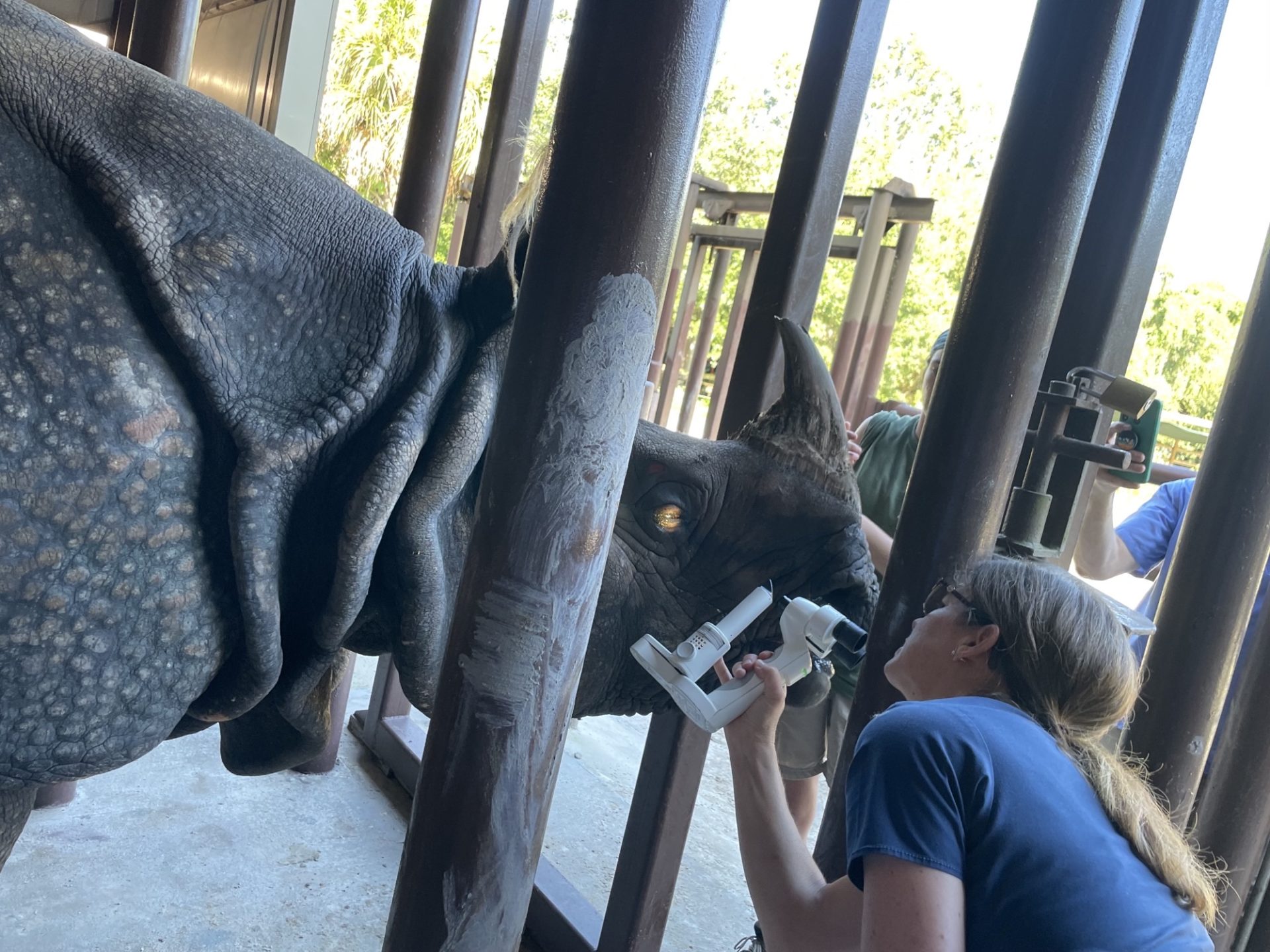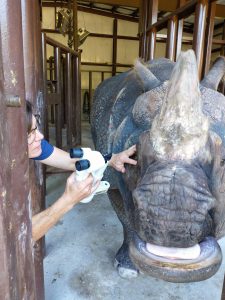If you’ve ever had an eyelash in your eye that just won’t come out, you know how annoying and even painful eye issues can be. Now imagine you have an infection that affects much of your cornea…and you’re a two-ton rhino who can’t do anything to fix it.
That’s the situation our beloved one-horned rhinoceros, PJ, was in late last year before our loving keepers, dedicated veterinary staff, and an awesome specialist stepped in to help.
Here at the Zoo, we often get questions about how we care for our animals and how we are able to get them to participate in essential veterinary care, so we wanted to share this story with you.
The story started when our team of keepers noticed that PJ’s right eye seemed squinty and had more tear production than normal. They reported this to our veterinary team, who initially suspected a corneal ulcer. They started treatment immediately. After a few days, Dr. Alex Mason, our associate veterinarian, checked the eye and did not see much healing.
At this time, the team decided to reach out to Dr. Heidi Denis,a board-certified veterinary ophthalmologist at Animal Eye Associates. Dr. Denis has been a valued consultant for the Zoo for many years.

Our team was able to gather photos and do preliminary testing while in communication with Dr. Denis, and she made a diagnosis of a corneal abscess. With her guidance, our veterinary team started an aggressive treatment plan of both topical and oral medications.
This was easier said than done, as many of the pet owners out there might imagine. Luckily for us, our team has spent many years working with PJ to get him to voluntarily participate in his care. They positively reinforced his behaviors with some of his favorite treats and tactile methods to ensure he took his eyedrops three times a day and took the full dosage of all of his oral medications. Dr. Mason monitored the eye and communicated with Dr. Denis, who was able to visit in person and check on PJ early in his progress. Our senior animal staff worked hard to coordinate all of the care needed, and our veterinary technician, Katrina, ensured that all of PJ’s medications were readily available.
It was truly a display of teamwork and highlights the extensive measures Zoos accredited by the
 Association of Zoos & Aquariums, like ours, take to ensure animal residents receive the highest level of care. This allowed us to make sure PJ not only healed, but that he was comfortable while doing so.
Association of Zoos & Aquariums, like ours, take to ensure animal residents receive the highest level of care. This allowed us to make sure PJ not only healed, but that he was comfortable while doing so.
There was nothing that could have prevented this from happening, and we likely won’t ever know what prompted this infection. But in the wild, it’s likely that PJ would have lost vision in his eye. It’s important to note that PJ’s relationship with our staff and the staff’s commitment to regular training to ensure PJ is willing to participate in his own care likely helped him have the best outcome possible.
Corneal ulcers or abscesses like this can also happen in horses, because they share some physiological traits with rhinos. Unlike many horses, however, PJ willingly participates in most of his care, which gave him good odds at recovering fully.
Our fun-loving rhino is back to his old self. While he might have a small scar from this experience, we are continuing to see improvement and progress, and we’re thrilled with the outcome.
We are so thankful for the guidance of Dr. Denis and for the hard work and care our vet team, keepers and beyond gave PJ throughout this experience. We’re proud that this is the same level of care we aim to provide for every animal resident at the Central Florida Zoo.
Be sure to stop by and give PJ a wave next time you visit!